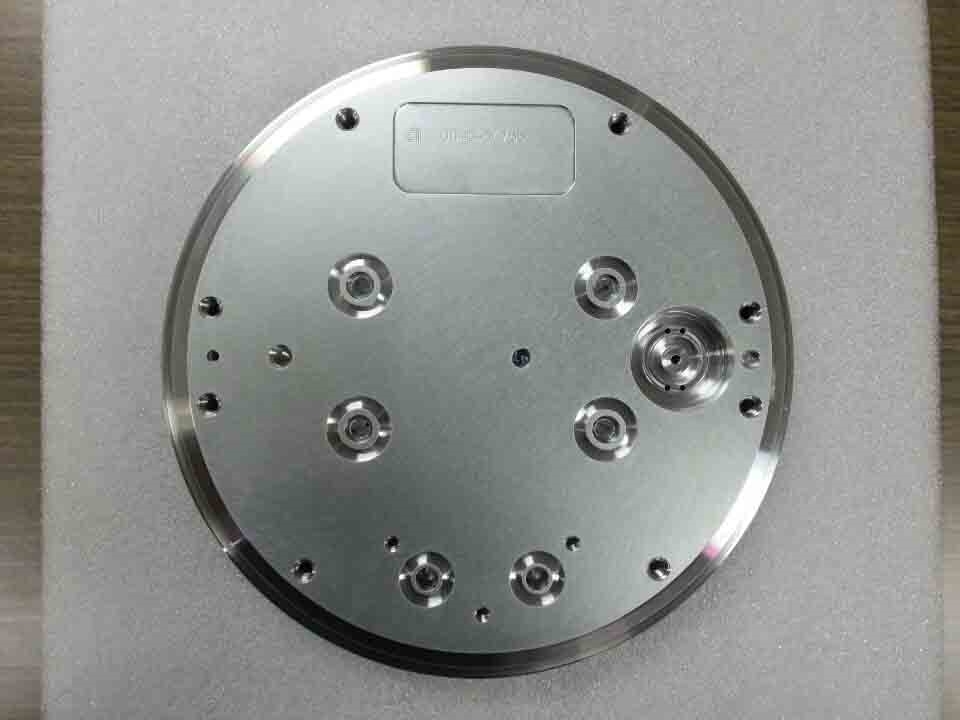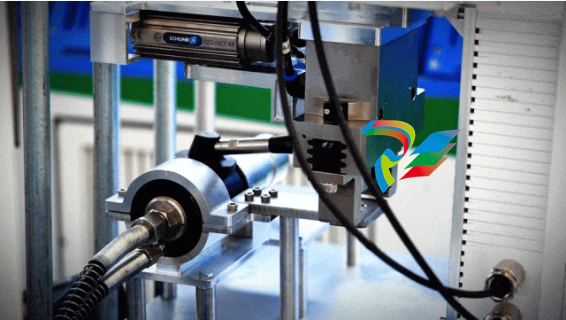

K-WANG


AMAT 0040-54755 Ceramic ESC Semiconductor
Research on the Application of AMAT 0040-54755 Ceramic Electrostatic Suction Disk (ESC) in Semiconductor Manufacturing
1、 Introduction
In modern semiconductor manufacturing, equipment precision and processing stability are the core driving forces behind technological progress. Especially in the wafer processing, the wafer needs to be accurately and firmly fixed on the processing platform to achieve precise etching, deposition, cleaning, and measurement processes. Electrostatic Chuck (ESC), as an efficient and safe wafer fixing device, is gradually replacing traditional mechanical fixtures and becoming an indispensable component in modern semiconductor equipment.
AMAT 0040-54755 is a high-end ceramic electrostatic suction cup launched by Applied Materials (AMAT) in the United States, widely used in key processes such as plasma etching, PVD, CVD, ALD, etc. Its high reliability, excellent thermal uniformity, and outstanding electrical performance make it stand out among advanced process nodes.
This article will systematically analyze the product structure, functional principles, application scenarios, manufacturing processes, and market trends of AMAT 0040-54755.
2、 Basic principle of electrostatic suction cup
1. Working principle
The core principle of an electrostatic suction cup is based on electrostatic mechanical effects, and its basic structure includes: electrode layer, insulating ceramic layer, heating layer, back cooling system, etc. ESC typically forms an electrostatic field between the electrode and the wafer by applying a direct current or high-frequency voltage to the electrode, thereby adsorbing the wafer.
According to the different structures of the electrodes, ESC can be divided into two categories:
Monopolar ESC: Suitable for conductive wafers, with a simple structure.
Bipolar ESC: Suitable for non-conductive wafers, it generates electrostatic adsorption through two opposing electrodes.
2. Advantages of ceramic materials
AMAT 0040-54755 ESC uses high-purity alumina or aluminum nitride ceramics, and its main advantages include:
Strong insulation: Ensure electrical isolation between the electrode and the external environment to avoid the risk of leakage.
High thermal conductivity: helps maintain uniformity in wafer heating or cooling.
Good corrosion resistance: able to withstand plasma and corrosive gas environments.

Good thermal stability: suitable for high-temperature plasma treatment.
3、 AMAT 0040-54755 ESC Product Structure and Features
1. Product Structure
The typical structure of this ESC product is as follows:
Top ceramic panel: In direct contact with the wafer, it has good thermal conductivity and electrical insulation.
Electrode layer: embedded in ceramics, responsible for generating electrostatic forces.
Heating layer (optional): used to control wafer temperature, usually a thin film heater.
Cooling system: Maintain heat exchange between the wafer and the suction cup through helium back pressure.
Vacuum channels and positioning pin holes: assist in precise positioning of wafers and circulation of process gases.
2. Technical parameters (example)
Parameter values
Material: Aluminum Nitride/Aluminum Oxide Ceramic
Compatible with 300mm wafer size
Electrode type: Bipolar ESC
Working voltage 0~1000V DC
Working temperature from room temperature to 350 ° C
Vacuum adaptation supports high vacuum and plasma chamber environments
Back pressure control helium channel system (He Backside Pressure)
4、 The role of AMAT ESC in semiconductor processes
1. Plasma Etching
During the etching process, the wafer needs to be fixed in the reaction chamber to undergo high-energy plasma treatment. ESC provides a non mechanical adsorption method that avoids contamination and damage caused by fixtures while maintaining high stability. The ceramic material of AMAT 0040-54755 ESC has high resistance and corrosion resistance, making it particularly suitable for long-term operation in fluorine based plasma.
2. PVD and CVD
In physical vapor deposition (PVD) and chemical vapor deposition (CVD), ESC requires precise control of wafer temperature to ensure thickness uniformity and adhesion of thin film deposition. The high thermal conductivity of ceramic ESC enables it to quickly respond to temperature control systems.
3. ALD (Atomic Layer Deposition)
The ALD process requires extremely high temperature uniformity and process stability. AMAT's ceramic ESC ensures minimal temperature fluctuations on the wafer surface, thereby improving the uniformity and reliability of the film.
5、 Manufacturing and Quality Control Process
1. Ceramic molding process
The manufacturing of ceramic ESC begins with the formation of ceramic bodies, mainly through hot pressing sintering (HP) and isostatic pressing sintering (CIP), supplemented by high-temperature sintering furnace treatment.
2. Electrode embedding
By using laser processing or screen printing to embed electrodes inside ceramics, and then encapsulating them through multi-layer stacking technology, the electrodes can ensure long-term stable operation.
3. Vacuum sealing and testing
After the whole machine is assembled, it is ensured that there are no hidden dangers such as gas leaks or internal cracks through helium leak detection, X-ray inspection, and other methods.
4. Temperature uniformity test
Use an infrared thermal imager to detect the uniformity of surface heating on ESC, with a control error within ± 2 ° C.
6、 AMAT's technological advantages and market position
As a leading global semiconductor equipment supplier, AMAT has accumulated decades of research and development experience in the ESC field, and its ESC products have the following advantages:
Highly customizable capability: can provide personalized design based on the customer's cavity structure.
High reliability: The average lifespan of the product can reach more than 5 years, and it is suitable for various corrosive environments.
Complete service network: There are maintenance and technical support centers worldwide.
In the global ESC market, AMAT competes with manufacturers such as SHINKU, TOTO, and II-VI Maruwa, and its advantages in high-end equipment and advanced process nodes are particularly evident.
7、 Market prospects and technological trends of ESC
1. Market growth drivers
The development of advanced processes such as 3nm and 2nm places higher demands on the thermal stability and temperature control accuracy of ESC.
3D NAND, HPC, and AI chip manufacturing require more complex multi-layer etching processes.
The process of new materials such as GaN and SiC is gradually maturing, and the demand for compatibility of adsorption devices is increasing.
It is expected that by 2030, the global ESC market size will reach over 2 billion US dollars, with a compound annual growth rate of over 10%.

2. Direction of technological evolution
Double sided heating ESC: supports more complex temperature control strategies.
Intelligent ESC: Embedded with temperature, voltage, and pressure sensors to achieve self-monitoring and feedback regulation.
Low particle design: using plasma cleaning and other methods to improve surface cleanliness and reduce particle pollution.
- YOKOGAWA
- Energy Access
- Renewable Integration
- Energy Subsidies
- Energy and Water
- Net zero emission
- Energy Security
- Critical Minerals
- A-B
- petroleum
- Mine scale
- Energy and Gender
- Covid-19
- man-machine
- Reliance
- ADVANCED
- SEW
- ProSoft
- WATLOW
- Kongsberg
- FANUC
- VSD
- DCS
- PLC
- Sewage treatment
- cement
- Yaskawa
- Woodward
- BOSCH Rexroth
- MOOG
- General Electric
- American NI
- Rolls-Royce
- CTI
- Honeywell
- EMERSON
- Automobile market
- xYCOM
- Motorola
- architecture
- Industrial information
- New energy
- electricity
- Construction site
- HIMA
- ABB
- Rockwell
- Schneider Modicon
- Siemens
- MAN
- GE
- TRICONEX
- Control Wave
- ALSTOM
- AMAT
- STUDER
- KONGSBERG
- MOTOROLA
- DANAHER MOTION
- Bentley
- Galil
- EATON
- MOLEX
- Triconex
- DEIF
- B&W
- ZYGO
- Aerotech
- DANFOSS
- KOLLMORGEN
- Beijer
- Endress+Hauser
- schneider
- Foxboro
- KB
- REXROTH
- YAMAHA
- Johnson
- Westinghouse
- WAGO
- TOSHIBA
- TEKTRONIX
-
Kollmorgen S33GNNA-RNNM-00 - Brushless Servo Motor
-
Kollmorgen 6sm56-s3000-g-s3-1325 - Servo Motor
-
Kollmorgen AKM52K-CCCN2-00 - Servo Motor
-
Kollmorgen PSR3-230/75-21-202 - Power Supply
-
Kollmorgen akm24d-anc2r-00 - Servo Motor
-
Kollmorgen AKM22E-ANCNR-00 - Servo Motor
-
Kollmorgen S60300-550 - Servo Drive
-
Kollmorgen B-204-B-21 - Servomotor
-
Kollmorgen AKM21E-BNBN1-00 - Servo Motor
-
Kollmorgen TT2953-1010-B - DC Servo Motor
-
Kollmorgen pa8500 - Servo Power Supply
-
Kollmorgen BDS4A-210J-0001-207C2 - Servo Drive
-
Kollmorgen TTRB1-4234-3064-AA - DC Servo Motor
-
Kollmorgen MH-827-A-43 - Servo Motor
-
Kollmorgen AKM24D-ACBNR-OO - Servo Motor
-
Kollmorgen 00-01207-002 - Servo Disk DC Motor
-
Kollmorgen AKM21C-ANBNAB-00 - Servo Motor
-
Kollmorgen PSR3-208/50-01-003 - Power Supply
-
Kollmorgen 6SM56-S3000 - Servo Motor
-
Kollmorgen DBL3H00130-B3M-000-S40 - Servo Motor
-
Kollmorgen 6SN37L-4000 - Servo Motor
-
Kollmorgen AKM65K-ACCNR-00 - Servo motor
-
Kollmorgen 6SM56-L3000-G - Servo Motor
-
Kollmorgen AKMH43H-CCCNRE5K - Servo Motor
-
Kollmorgen PSR4/52858300 - Power Supply
-
Kollmorgen KBM-79H03-E03 - Direct Drive Rotary Motor
-
Kollmorgen AKM33E-ANCNDA00 - Servo Motor
-
Kollmorgen U9M4/9FA4T/M23 - ServoDisc DC Motor
-
Kollmorgen AKM13C-ANCNR-00 - Servo Motor
-
Kollmorgen AKM43L-ACD2CA00 - Servo Motor
-
Kollmorgen AKM54K-CCCN2-00 - Servo Motor
-
Kollmorgen M-605-B-B1-B3 - Servo Motor
-
Kollmorgen AKD-P00606-NBAN-0000 - Rotary Drive
-
Kollmorgen 6SM-37M-6.000 - Servo Motor
-
Kollmorgen A.F.031.5 - Sercos Interface Board
-
Kollmorgen 918974 5054 - Servo PWM
-
Kollmorgen U12M4 - ServoDisc DC Motor
-
Kollmorgen AKD-B00606-NBAN-0000 - Servo Drive
-
Kollmorgen MV65WKS-CE310/22PB - Servo Drive
-
Kollmorgen 65WKS-CE310/22PB - Servo Drive
-
Kollmorgen EM10-27 - Module
-
Kollmorgen S64001 - Servo Drive
-
Kollmorgen CR03200-000000 - Servo Drive
-
Kollmorgen 6SM57M-3000+G - Servo Motor
-
Kollmorgen BDS4 - Servo Drive
-
Kollmorgen AKD-P00306-NBEC-000 - Servo Drive
-
Kollmorgen AKD-B01206-NBAN-0000 - Servo Drive
-
Kollmorgen STP-57D301 - Stepper Motor
-
Kollmorgen 6SM37L-4.000 - Servo Motor
-
Kollmorgen 44-10193-001 - Circuit Board
-
Kollmorgen PRDR9SP24SHA-12 - Board
-
Kollmorgen PRD-AMPE25EA-00 - Servo Drive
-
Kollmorgen DBL3N00130-0R2-000-S40 - Servo Motor
-
Kollmorgen S406BA-SE - Servo Drive
-
Kollmorgen AKD-P00607-NBEI-0000 - Servo Drive
-
Kollmorgen AKD-P01207-NBEC-0000 - Servo Drive
-
Kollmorgen CR03550 - Servo Drive
-
Kollmorgen VSA24-0012/1804J-20-042E - Servo Drive
-
Kollmorgen N2-AKM23D-B2C-10L-5B-4-MF1-FT1E-C0 - Actuator
-
Kollmorgen 04S-M60/12-PB - Servo Drive
-
Kollmorgen H33NLHP-LNW-NS50 - Stepper Motor
-
Kollmorgen A-78771 - Interlock Board
-
Kollmorgen AKM43E-SSSSS-06 - Servo Motor
-
Kollmorgen AKD-P00607-NBEC-0000 - Servo Drive
-
Kollmorgen E21NCHT-LNN-NS-00 - Stepper Motor
-
Kollmorgen cr10704 - Servo Drive
-
Kollmorgen d101a-93-1215-001 - Motor
-
Kollmorgen BDS4A-203J-0001-EB202B21P - Servo Drive
-
Kollmorgen MCSS23-6432-002 - Connector
-
Kollmorgen AKD-P01207-NACC-D065 - Servo Drive
-
Kollmorgen CK-S200-IP-AC-TB - I/O Adapter and Connector
-
Kollmorgen CR10260 - Servo Drive
-
Kollmorgen EC3-AKM42G-C2R-70-04A-200-MP2-FC2-C0 - Actuator
-
Kollmorgen BDS5A-206-01010-205B2-030 - Servo Drive
-
Kollmorgen s2350-vts - Servo Drive
-
Kollmorgen AKM24D-ANC2DB-00 - Servo Motor
-
Kollmorgen E31NCHT-LNN-NS-01 - Stepper Motor
-
Kollmorgen PRD-0051AMPF-Y0 - Servo Board
-
Kollmorgen TB03500 - Module
-
Kollmorgen 60WKS-M240/06-PB - Servo Drive
-
Kollmorgen M21NRXC-LNN-NS-00 - Stepper Motor
-
Kollmorgen H-344H-0212 - Servo Motor
-
Kollmorgen MCSS08-3232-001 - Connector
-
Kollmorgen AKM33H-ANCNC-00 - Servo Motor
-
Kollmorgen PA-2800 - Power Supply
-
Kollmorgen MTC308C1-R1C1 - Servo Motor
-
Kollmorgen PRDR0091300Z-00 - Capacitor Board
-
Kollmorgen BDS4A-206J-0024/01502D79 - Servo Drive
-
Kollmorgen S20330-VTS - Servo Drive
-
Kollmorgen S20250-CNS - Servo Drive
-
Kollmorgen SBD2-20-1105-WO - Servo Drive Board
-
Kollmorgen M405-C-A1--E1 - Servo Motor
-
Kollmorgen PRD-PB805EDD-00 - Servo Drive
-
Kollmorgen 6SM57S-3.000-J-09-HA-IN - Servo Motor
-
Kollmorgen AKM33H-ANCNDA-00 - Servo Motor
-
Kollmorgen PCB-00030200-04 - PCB
-
Kollmorgen H22SSLB-LNN-NS-02 - Stepper Motor
-
Kollmorgen BJRL-20012-110001 - Module
-
Kollmorgen BDS4A-206J-0001404A - Servo Drive
-
Kollmorgen H-342-H-0802 - Servo Motor
-
Kollmorgen CR10561 - Servo Drive
-
Kollmorgen BDS5A-206-00010-205B2-030 - Servo Drive
-
Kollmorgen BDS5A-206-00010-207B-2-030 - Servo Drive
-
Kollmorgen mcss08-3224-001 - Connector
-
Kollmorgen M-207-B-23-B3 - Servo Motor
-
Kollmorgen PRD-0041200Z-S0 - Encoder/Resolver Card
-
Kollmorgen MH-225-G-61 - Motor
-
Kollmorgen MT308B1-T1C1 - Servo Motor
-
Kollmorgen BDS4A-240J-0001604C83 - Servo Drive
-
Kollmorgen 6SM57-S-3000 - Servo Motor
-
Kollmorgen N-T31V-15-5B-6-MF3-FT1E-C251 - Actuator
-
Kollmorgen PRD-0051AMPA-X0 - Servo Board
-
Kollmorgen CF-SS-RHGE-09 - Cable
-
Kollmorgen DIGIFAS7204 - Servo Drive
-
Kollmorgen S30101-NA - Servo Drive
-
Kollmorgen DIGIFAS7201 - Servo Drive
-
Kollmorgen PRD-0051AMPA-Y0 - Servo Board
-
Kollmorgen AKM23D-EFCNC-00 - Servo Motor
-
Kollmorgen SE10000 - Servo Drive
-
Kollmorgen PSR4/5A-112-0400 - Power Supply
-
Kollmorgen AKM31H-ANCNC-01 - Servo Motor
-
Kollmorgen M-203-B-93-027 - Servo Motor
-
Kollmorgen CP-SS-G1HE-05 - Connector
-
Kollmorgen AKM42G-ASCNR-02 - Servo Motor
-
Kollmorgen DBL4N00750-B3M-000-S40 - Servo Motor
-
Kollmorgen R3-BK23-152B-12-PL-ASE-BS115 - Actuator
-
Kollmorgen MH-427-B-61 - Motor
-
Kollmorgen cr06902 - Servo Drive




